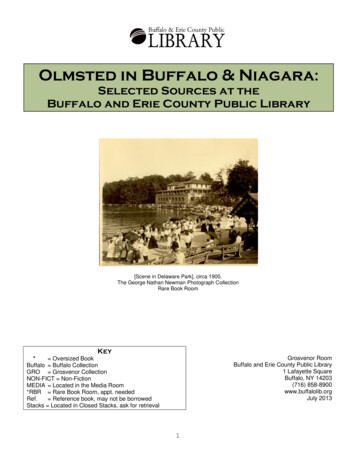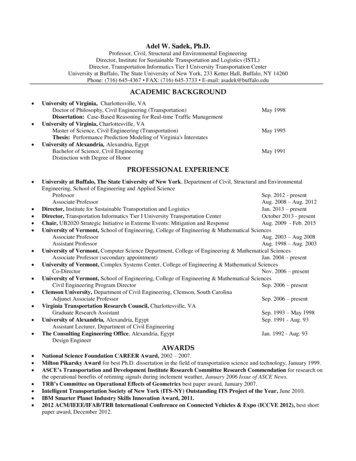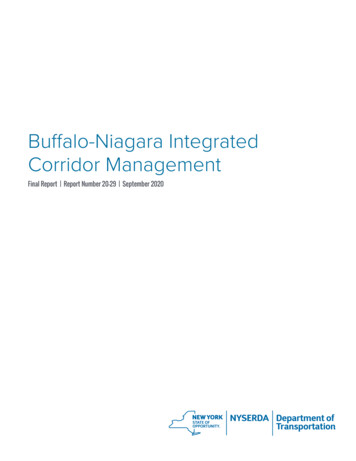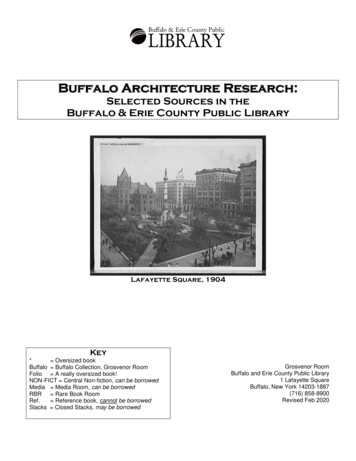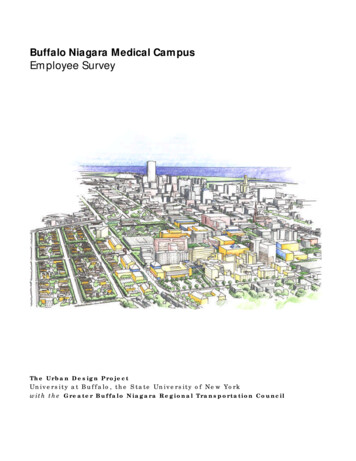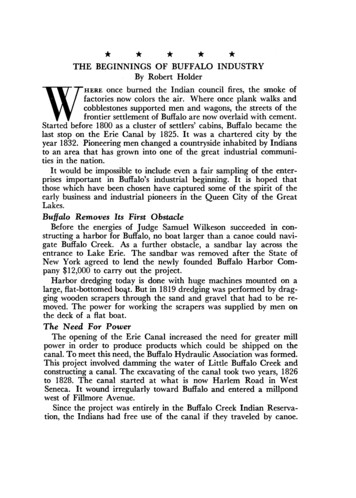
Transcription
*****THE BEGINNINGS OF BUFFALO INDUSTRYBy Robert HolderWHERE once burned the Indian council fires, the smoke offactories now colors the air. Where once plank walks andcobblestones supported men and wagons, the streets of thefrontier settlement of Buffalo are now overlaid with cement.Started b fore 1800 as a cluster of settlers' cabins, Buffalo became thelast stop on the Erie Canal by 1825. It was a chartered city by theyear 1832. Pioneering men changed a countryside inhabited by Indiansto an area that has grown into one of the great industrial communities in the nation.It would be impossible to include even a fair sampling of the enterprises important in Buffalo's industrial beginning. It is hoped thatthose which have been chosen have captured some of the spirit of theearly businessand industrial pioneers in the Queen City of the GreatLakes.Buffalo Removes Its First ObstacleBefore the energies of Judge Samuel Wilkeson succeeded in constructing a harbor for Buffalo, no boat larger than a canoe could navigate Buffalo Creek. As a further obstacle, a sandbar lay across theentrance to Lake Erie. The sandbar was removed after the State ofNew York agreed to lend the newly founded Buffalo Harbor Company 12,000 to carry out the project.Harbor dredging today is done with huge machines mounted on alarge, flat-bottomed bo t. But in 1819 dredging was performed by dragging wooden scrapers through the sand and gravel that had to be removed. The power for working the scrapers was supplied by men onthe deck of a flat boat.The Need For PowerThe opening of the Erie Canal increased the need for greater millpower in order to produce products which could be shipped on thecanal. To meet this need, the Buffalo Hydraulic Association was formed.This project involved damming the water of Little Buffalo Creek andconstructing a canal. The excavating of the canal took two years, 1826to 1828. The canal started at what is now Harlem Road in WestSeneca. It wound irregularly toward Buffalo and entered a millpondwest of Fillmore Avenue.Since the project was entirely in the Buffalo Creek Indian Reservation, the Indians had free use of the canal if they traveled by canoe.
Others who used the canal paid a toll charge for hauling grain, livestock, produce, lumber, or logs.The canal became a serious health problem as Buffalo expanded. Theslaughter houses and tanneries along its banks used the canal to dispose of waste materials. Many times the canal was red with the bloodydischarges from the packing plants.Legal action to remedy this problem started in 1851. The canal wasfinally covered in the 1880's. The increased use of steam power helped to outmode the Hydraulic Canal.Little Buffalo Creek was then known as the Commercial Slip. Todayit is remembered only when one locates the bridge of the D. L. andW. (Lackawanna) Railroad which crosses its outlet at the foot ofCommercial Street. This is the place where boats once left for Canada'sCrystal Beach.The Coming of City WaterThe Jubilee Water Works Company opened for business on July4, 1826. The company supplied water through logs to Black Rock. Thewater, dra\vn from Jubilee Springs, was later supplied to Buffalo in 1829and was transported through logs laid down Main Street to the canalbasin. An historical marker. places the original site on the north sideof Delaware Avenue, a few hundred feet from Gates Circle near Millard Fillmore Hospital.Buffalo in 1836So rapid was the march of improvements in Buffalo, that by theyear 1836 there were 52 miles of finished road in the city. On someof the prominent streets the sewerage system was well-developed.Rev. George W. "Hosmer, in a paper read before the HistoricalSociety in 1880, referred to the city as follows:So came the Buffalo of 1836. We can see the old signs now alongthe docks and upon Main Street. Joy and Webster, Sheldon Thompson and Co., Smith and Macy, Wilkeson and Beals, Townsend andCoit, Hollister Brothers, Oliver Forward, Reuben B. Heacock, JudgeLove, Dr. Johnson, Pratt and Company, William Williams, S. N.Callender, N. P. Sprague, General Potter, Albert H. Tracy, MillardFillmore, N. K. Hall, Ira A. Blossom, H. K. Smith, Barker, Hawleyand Sill .Ihave always thought it was a remarkable companyof men here in Buffalo in that first period of the city .Andtherewere here in Buffalo, forty years ago, a company of women superioras the men. The new life quickened them and gave spirit and forceto the culture and habits they brought with them from older communities.?
JubileeWater Works, DelawareAvenue at Auburn.Lumber Trade DevelopsAs late as 1825 there was no saw or planing mill listed in the localrecords. There were carpenters and joiners, and two cabinetmakingshops. Perhaps the lumber came from sawmills which were establishedabout 1800 up the Scajaquada and Ellicott Creeks.It was not until the 1850's that Buffalo developed a large lumbertrade. Cargoes from Southern Ontario and Michigan were transferredat Buffalo to the canal boats which moved the lumber on to Albany.About 1857 a number of Buffalo enterprisers tried to float log raftsfrom Saginaw, Michigan to Buffalo. The undertaking was given upafter a number of rafts were lost.John S. Noyes bought the hulk of a ship that had once been a floating palace, and in 1861 he turned it into a barge to haul lumber. Soonafter this venture a great number of barges, carrying whatever couldbe taken aboard, appeared on Lake Erie.In 1860 about 111,000,000 feet of lumber came to Buffalo by lakebarge, with none shipped by rail. By 1890 rail shipments were 375,000,000 feet, and lake imports were 287,000,000 feet. This indicatedthat the railroads were replacing the barges as the popular carrier oflumber for the Queen City.The Enterprising GoodyearsThe name of Goodyear looms large in the history of lumber on theNiagara Frontier. The enterprises of Frank H. and Charles W. Goodyear brought them personal profit and benefitted th community inmany ways.While other lumber dealers passed by good forests that were farfrom water transportation, Frank H. Goodyear invested heavily inisolated forest holdings. He built his own sawmills. Then he promptlyconnected them with shipping centers, by laying out his own railroads3
Factory,NorthTonawanda,New York.to reach the busy mills. In 1885 he bought 13,000 acres of woodlandin Potter County, Pennsylvania. The railroad he built for this venturelater became part of the Buffalo and Susquehanna Railroad which gaveBuffalo easy accessto coal as well as to timber .In 1887 Frank entered into partnership with his brother, Charles,:ind by 1902 the Goodyear Lumber Company was incorporated. Typicalof the advanced thinking of the Goodyears was the building of a sawmillof steel- the first of its kind. The output of this mill was expectedto exceed that of any other sawmill in the world at that time.The Goodyear brothers' interests included the Buffalo and Susquehanna Coal and Coke Company, the Buffalo and Susquehanna steamship Company, the Great Southern Lumber Company, and the MarineNational Bank of Buffalo, of which both brothers were directors.Furniture and Billard T able ManufacturingOne would expect Buffalo to have numerous furniture manufacturersto take care of the home needsof the expanding population. The CutlerDesk Company was established in 1824 as a small cabinetmaking shop.By 1884 it employed 100 men and sold its furniture nationally. Thisfactory bummeddown three times, but it was rebuilt after each fire andbusiness continued as usual.The Brunswicke-Balke-Collender Company in the 1880's had a factory at 597 Main Street in which it manufactured billiard tables. Thiswas a popular item of production in Buffalo in the early days. At leastfive individuals and companies made this equipment. It is recorded thatthe first billiard table made in New York State, west of New York City,was made in Buffalo in 1825.4
ShiPYard Industry BoomsThe sharp smell of pitch, the sight of snake-like coils of rope, and thenever-ending sound of hammers and wood-scrapers were the signs ofthe booming shipyard industry along Buffalo Creek. Keels for lakesailboats and steamers were laid at Buffalo and Black Rock. Therewas great demand by the settlers for transportation from the end of theErie Canal to points farther west. In the year 1833 alone, 50,000 passengerswere transported westward across Lake Erie from Buffalo.To keep the cost of passage down, the boat builders constructedshelves and tables in the steerage. Stoves were set up for cooking sothat the emigrants could prepare and serve their own meals on boardship.A total of 30 steamers, characterized by their billowing white cloudsof wood smoke, were built in Buffalo between the years of 1818 and 1857.Starting with the steamer W alk-in-the- Water , built in 1818, nine moreships were constructed at Black Rock by the year 1843 when the Unionwas launched.The first tragic lake-steamer explosion happened at Buffalo whenthe Peacock burst her boiler while tied up at the wharf in 1830. Whenthe water in her boiler ran low, a careless and inexperienced engi erturned a valve which gushed in a stream of cold water. The boilerblew up, and fifteen men were killed.Steamer construction in Buffalo hit a mad pace in the 1840's and1850's. During these years businessmen and tourists were leaving forDetroit and Chicago to join the large number of immigrants goingwest. Each year found the ships faster, larger, and more luxurious. Eventhe railroads built special steamers to make connections with their linesat the other end of the lakes. But too many ships were built, even forthe rapidly increasing lake traffic. In 1857 the shipowners went bankrupt becauseof over expansion. Much of the lake passengerand freightbusiness was drained off by the new railroads. Handsome rosewoodfinished ships, now too fancy for the regular lake trade, were dockedand used for less elegant purposes. The shipping businesssimply couldnot continue to operate without a profit.Later ships were built specifically for transporting coal and grainbetween Buffalo and other lake cities. In the 1870's a fleet of schoonerswas constructed for hauling cargoes between Buffalo and Chicago andMilwaukee.Flour Milling Starts SlowlyThere was no milling industry in pioneer Buffalo -justthe usualgrist mills out in the country. But then the immigrants who had pouredinto the West began to seed the prairies with golden wheat. Before too5
many years, the grain trade on theGreat Lakes expanded considerably.In 1829 Buffalo handled 7,975 bushels of flour and wheat. By 1830,just one year later, the combinedshipments were 181,029 bushels. Bythe time the first grain elevator wasput up in 1842, the flour and grainimports had soared to 3 millionbushels!Joseph Dart was watching grainbeing unloaded at the Buffalo wharves one day in 1841. Slowly and laboriously the grain was cupped intobuckets. I t was then carried on thebacks of strong Irish dock workersBuffalo,1850,ShowingDartElevator. into the warehouses to be weighedand recorded. Not more than 2,000bushels a day could be moved out of a ship's hold when this age-oldmethod was used.J oseph remembered the invention of a pioneer American miller ,Oliver Evans, who had originated and patented a conveyor belt foruse in grain milling. Not a hand touched the milled flour as it wastransported on a leather belt revolving on pulleys from the millstonesto the hopper box. Dart wondered why this device couldn't be adaptedto the unloading and storing of grain at the jammed Buffalo piers.Amid the jeers of doubtful onlookers, Dart put up a building onBuffalo Creek. He oonstructed a large warehouse and installed a perpendicular conveyor belt fitted with buckets that could elevate thegrain from the ship's hold to the storage house. This elevator waspowered with a steam engine. He was then ready to transfer grainfrom the lake carriers to either the canal boats or to his storage bins.The innovation was an immediate success. The schooner, John S.Skinner, came in from Milan, Ohio and docked in the early afternoon.She was unloaded by Dart's system, took on a ballast of salt, and wasout of the harbor before dark. She was able to make a return trip toMilan and transfer her second cargo at Buffalo before other ships, beingemptied by the hand method, had finished unloading their first cargoes.The grain trade, with this automatic aid, was to advance Buffalo tothe position of the leading grain center in America.As late as 1881 wheat was ground on burr millstones. In that yearthe George Urban Milling Company introduced corrugated steel rollersfor the milling of flour .6
Buffalo was a natural place to make cereal, because grain could beso easily obtained by ship carriers. Alexander Horn by, the originatorof the rolled-oat breakfast cereal, brought the H-O Company to Buffalo in 1895. He then sold his rights for manufacturing his breakfastfood to Edward Ellsworth.TanningAn Important Early IndustryThe presence of easily available hemlock in the bordering forestsmade tanning one of the most important early Buffalo industries. Thesite of the first tannery , established in 1812 by Samuel Edsall, waslocated at what is now the corner of Niagara and Mohawk Streets.This building was used by the British General Riall as his temporaryheadquarters during the burning of Buffalo in 1813.A sizeable tannery was started by George Palmer in 1828. He cameto the area with the rather large sum of 15,000 to begin his businessand bought land near Seneca Street. The water power from the newlyconstructed Hydraulic Oanal, had attracted him to this rather unlikelylocation. The marketplace for the finished leather that he made wason Main Street. This was the same George Palmer who later was tobecome President of the State Line Railroad, President of the MarineBank, and one of the incorporators of the Union Iron Works.The Rumsey name stands out in Buffalo's early leather industry.Aaron Rumsey, whose family was familiar with leather manufacturingfor generations, started business locally in .1834. After building up asizeable leather business, Aaron died in 1864. His two sons, Bronsonand Dexter Rumsey, further advanced the tanning business. By 1884their Buffalo plant and the Holland, New York plant turned out 200,000hides a year. By 1904, when the firm was taken over by the UnitedStates Leather Company, it was classified as one of the leading industries of that type.Jacob F. Schoellkopf immigrated to Buffalo from Germany. In theyear 1834 he opened a modest leather store on Mohawk Street. Jacob7
started with the purchase of a smalltannery in what is now Hamburg,New York -called White's Cornersin. those days. He established asheepskin tannery in Buffalo in 1846and kept enlarging his operationsuntil he eventually owned tanneriesin Milwaukee, Chicago, and othercities. At the time of his death, inthe year 1899, every variety ofleather which could be made fromsheepskin was manufactured in theSchoellkopf plants. Sales agenciesin South America, England, andFrance were maintained by the enterprising tanners.Weed and Company, originatingin 1818, and Beals, McCarthy, andRodgers both wholesaled leatherExcerptfromBuffaloGazette,1812. goodssuch as belting. Belting manufacturing became important whenindustries added more machines.Large supplies of belts were needed to harness power for turningmachine wheels.The first shoe factory in the city of Buffalo was established in 1853.This was the Forbush and Brown plant at 103 Main Street. JohnBlocher and Nelson y.i. Blocher operated plants at 64 Exchange Street,starting in 1863, and employed several hundred workers. As late as1923 there were twelve shoe factories in Buffalo. Today there are noshoe manufacturers in the city.Livestock Industry GrowsIt would be hard to say just when the livestock business began inBuffalo. But in 1852, according to one Buffalo historian, H. PerrySmith :It was no uncommon sight in those days to see a drove of hogs,cattle, and sheep over a mile in length, reaching from the footof Main Street out towards the stock pens. Many fine 'porkers'found their way, from those droves, under the barns or into theyards of residents along the road and were never claimed by theowners. A shortage of a few head in every drove was, in thosedays, not an unusual thing.About 1855 the New York Central and the New York and Erie Rail8
road companies built pens and chutes for loading hog and cattle cars.Before that, the stock was unloaded on long planks set up againstthe cars.A seventeen-year-old German immigrant, Christian Klinck arrivedin Buffalo in the 1850's. He had only enough money to pay his railwayfare to Buffalo, but he immediately gained work as a butcher andearned 6 a week. By 1868, through thrifty saving, he was able toenter the meatpacking businessand founded the Christian Klinck Packing Company. His South Buffalo enterprise on Depot Street eventuall,Y covered twenty-five acres and comprised twenty-five buildings.Today, Klinck & Schaller, Inc., under the presidency of ChristianKlinck's grandson, is the continuation of this pioneer Buffalo firm.The Jacob Dold Packing Company was started in 1860. At that time,.JacobDold, Sr. had a small butchering establishment on Abbott Road.Two years later he set up a packing plant at the Elk Street Market.By 1872 he was doing businessat a location in East Buffalo. An annualpayroll of 3,000,000 covering 2000 workers, marked the progress ofthe company by 1920.In comparing pioneer meatpacking with the meat processing of moremodem times, J acob Dold, president of the company, said the following in the Buffalo Year Book of 1920:There was then none of the modem efficiency which is nowknown all over the world, as being one of the most importantfeatures in every up-to-date packing house. .Asthe industry.grew,new methods. .ofcuring and chilling productsgradually changed the great waste of edible meats which nowgoes into scores of tempting and appetizing food products.Other important packing houseswere the Danahy Packing Company,Klinck Brothers, Louis Fuhrmann, Laux and Edbauer, and the NewEn,gland Dressed Meat and Wool Company.Besides being a livestock center, ranking highest in sheep handling,Buffalo was also the second greatest horse market in the country. Twolarge commission dealers in horses were the Bailey Horse Company,located at 23-25 Newell Street and the Crandall Horse Company at949 William Street.Pioneer Spaulding's Community ContributionsElbridge Gerry Spaulding, whose grandfather fought at the Battleof Bunker Hill, came to Buffalo in 1834 as a young lawyer. He is agood example of the type of pioneer Buffalonian who helped advancethe industrial progress of the Niagara Frontier. Banks, such as theFarmers' and Mechanics' Bank which Spaulding brought to Buffalo,are an essential factor in the industrialization of an area. The Buffalo9
Gas Company, organized in 1848 through his support, and the generalsewerage system for the city which Spaulding introduced were alsonecessary before the industrial life of Buffalo could progress.The active part he played in enlarging canal and harbor facilitiesin Buffalo and in financing railroads to service industry promoted thecity's growth. As financier, mayor of the city, and Congressman, hisactivities constantly promoted the well-being of Buffalo's industry.George W. Tifft -PioneerCapitalistThe name of George W. Tifft is recorded in Buffalo histories as amonument to enterprise and character seldom matched in pioneer tales.Not content with the yoke of oxen and a horse that were to be his ownwhen George came of age, he left the family farm.One of his first enterprises was to buy five acres of land in OrleansCounty in Eastern New York which he cleared, selling the wood at ahandsome profit. When he realized that he could hire men to chopthe timber, reaping a profit on the labor of each man, he bought alarger tract and engaged more woodchoppers.At the age of 21 he had accumulated 1,200. To this, George addeda thousand dollars which was due him from his father's estate. Hewas ready to begin a new businessventure. The year 1841 saw manymen moving west, so George Tifft traveled to Michigan where hebought grain for shipment to the east. While doing businessin Michigan, he came to know Buffalo shippers and eventually moved to theircity.When George Tifft came to Buffalo in 1842, he formed a partnership and entered the milling businesswith Dean Richmond -a memberof a prominent Buffalo family. A year later Tifft set up a transportation system called the Troy and Michigan Six-day Line, so named because it was not in operation on Sunday. His fortunes advanced, andin 1844 he was in the produce and commission business. The purchaseof other mills further increased his commercial holdings.Tifft helped to establish the International Bank of Buffalo and wasmade its first president in 1854. He was also interested in the BuffaloSteam Engine Company in which he invested 100,000. The panicof 1857 hit him heavily, but not enough to stop his business successes.In 1858 he was elected president of the New York, Lake Erie andWestern Railroad which connected towns between Buffalo and Corning,New York.Next, he turned his attention to improving some of his Buffalo realestate holdings. In the year 1863 he erected 74 houses, a hotel -theTifft House, and an elevator. Tifft's foresight caused him to buy a600-acre tract of land in the southern portion of Buffalo, generally10
Buffalo Forge Company,cornerMortimer and Broadzvay,1883and today.known then as the TifftFarm.This was later broken up into residential and industrialareas which are, today, worth millions of dollars.Tifft'sinterests were far-reaching.He was the first to experimentwith winter wheat, despite the laughter of area residents.He investedmuch of his money in the Pennsylvaniacoal fields and experimentedwith smelting the Lake Superior iron ore with mineral coal. His land interests reached half-wayacross the country;at one time he owned a5000-acre farm in Shelby County, Iowa, completelystocked and c'ultivated.He could be selected as a representativeof Buffalo'sindustrialists whose importancebecame national.He spent the latter years of his life managingThe George W. Tifft,Sons and Company,successors to his originalBuffalo Engine Works.Over 400 persons were on the payroll of this major manufacturerofboilers and stationaryengines. He also erected a group of stores at thecorner of Washingtonand MohawkStreets and opened a furniturebusiness there.BuffaloandthePetroleumIndustryOil for lighting and lubricationin early Buffalo was a product manufacturedfrom lard and other fats. Petroleum,at that time, could bepurchased only in drug stores -SenecaOil it was called locally andwas used medicinally.Traditionhas it that, back in 1820, an old manon a white horse with two gallon kegs strappedto the saddle wouldcome to Buffalo each spring.He sold petroleumwhich he had soppedup from "Oil Creek" by the ingenious process of laying a wool blanketon the surface of the spring from which gushed oil and water.When oil was discovered at Titusville,Pennsylvaniain 1859, Buffalobusinessmen were among the first to put their money into the development of this new industry.Althoughmuch of Buffalo's capital pouredinto the early petroleumventures, it was not until 1873 that any attempt was made to refine crude oil in Buffalo.Joseph D. Dudleystarted the Empire Oil Works, located on the Ohio Basin. The Standard Oil Companytook over the Dudleyplant in 1878. The AtlasWorks, built by the KalbfleischSons, was taken over by the StandardOil Company in 1892.11\;.
Charles B. Mat thews established the Buffalo Lubricating Oil Company in 1881 but sold it in 1887 to outside capitalists. A year later heorganized a new company, the Buffalo Refining Company, but this timehe had his refining done in Pennsylvania. Two other refineries, theNiagara and the Phoenix, both built in 1881 on the Tifft Farm, failed.The Solar Oil Works were established in 1880 by Buffalo and Titusville interests. Three years later the Tidewater Pipe Line Companytook over the Solar Oil Works, and this organization was then boughtby Standard Oil to add to its fabulous oil empire. By 1892 the Standard Oil Company controlled most of the oil businessin Buffalo.Railroads Reach Out From BuffaloThe nine-day trip from New York to Buffalo on the Erie Canalsatisfied most Buffalonians. However, a number of residents lookedahead to railroad transportation and did their best to foster it.In a Buffalo Journal dated September 6, 1831, this announcementappeared:Railroad. .Ata numerous and respectable meeting of thecitizens of Buffalo, held at the Eagle Tavern on the 6th of September, for the purpose of taking into consideration the subjectof railroad communication between this place and the HudsonRiver, Bela D. Coe was called to the chair, and James Strykerwas appointed secretary.On April 14, 1832, two railroad companies were incorporated. One,called the Buffalo and Erie Railroad, was to run from Buffalo throughChatauqua County to the Pennsylvania line. The other, the Auroraand Buffalo Railroad, was to connect Buffalo with the area that is nowcalled East Aurora. The money panic of 1837 caused these roads tofail before even a foot of track had been laid.A horse-powered street railway was opened in 1834, joining BlackRock with Buffalo. But the first railroad on the Frontier to be operatedby steam was the Buffalo and Niagara Falls Railroad which was builtin 1836.The Buffalo and Attica Railroad which was completed in 1843 joinedthe Queen City -throughSyracuse, U tica, and Schenectady -toAlbany. In 1851, when the Hudson River Road was opened to Albany,and the New York and Erie Railroad pushed its way through to Dunkirk, there were two direct rail routes between Lake Erie and NewYork City.One of the noted railway pioneers was William Wallace. Prior tothe time of his death, in 1887, Wallace had something to do with sevenout of the nine different railroads built. In a typical pioneer way hewas at different times a promotor, engineer, superintendent, railway1?
surveyor, and civic publicizer of the many railroads in which he wasinterested. His last project was a railroad, running from Buffalo toWashington, which later became a branch of the present PennsylvaniaRailroad.Buffalo's Street RailwaysBuffalo had a street railway system in which the cars were drawnby horses. Although this method of transportation was established asearlyas 1834, it was not until the year 1860 that lines were constructedto serve residents who had built homes out Main Street and along,Niagara Street towards Black Rock. An outstanding figure in streetcartransportation was Stephen Van Rensselaer Watson who -withG. R.Wilson, Charles T. Coit, and Andrew J. Rich -incorporatedthe Buffalo Street Railway Company in 1860.The first horse cars were 12 feet long. They were mounted on fourwheeled trucks, and each car cost about 700. The rails, made in tenfoot sections and bolted together to prevent spreading, were made ofcast iron overlaid in wood.By 1863 Buffalo boasted streetcar lines on its best streets. There wasa total of 11 miles of double track and 60 passenger cars. But thestreet railways were poorly patronized. Many citizens preferred to walkrather than pay five cents for the questionable privilege of ridingthe horse cars.BuffaloStreet Railway,Main13at NorthDivision,1888.
On March 11, 1888, the horse car had a rival- the electric trolley.Despite the protests of many Buffalonians who feared electrocution fromfalling trolley lines, the first overhead wires were strung from ColdSpring to Delaware Park on July 20, 1889. The last horse car ran onNovember 19, 1894. After that time, all streetcars were electricallypowered. Two years later the Buffalo trolley system tapped into theNiagara Power supply and became one of the first users of this electricenergy in Buffalo.Early IronworkersThe first ironworker to come to Buffalo was David Reese who wassent by the U.S. Government in 1803 to be blacksmith for the Indiansettlement. In 1808 he bought a lot and built a shop at the cornerof Washington and Seneca Streets to serve the growing village as wellas the Seneca Reservation. This was one of the two wooden buildingsnot bummedwhen the British attacked Buffalo in 1813.Plow-irons and small castings were made in Buffalo by Edward Rootas early as 1826. By 1864 there were twenty foundries and machineshops which filled orders for iron products.The first rolling mill, a factory where metal is rolled into sheets andbars, was constructed in Buffalo in 1846 by a group of men from Pittsburg, Pennsylvania. The business began as the Buffalo Iron and NailWorks. Some years later, Pratt and Company- iron and hardwaredealers -tookover the company. The manufacturing plant changedhands several times in the next twenty years, but it continued to employfrom 500 to 800 men. This enterprise helped to build up a section ofBuffalo that otherwise might not have expanded.The Pratt and Letchworth Company was a pioneer in the open-hearthsteel process in Buffalo. This company, formed in 1850 and composedof Samuel F. Pratt, Pascal Paoli Pratt, and William Pryor Letchworth,turned out steel castings as early as 1888.Pascal Paoli Pratt was only in his early forties when he rose to localfame as one of Buffalo's leading captains of industry. William PryorLetchworth sold his interest in the company to his brother, Josiah Letchworth, in 1873 and devoted the rest of his days to public affairs.This company, nationally famous for its saddlery hardware, foundedthe Buffalo Malleable Iron Works on Tonawanda Street in 1860. Asthe iron works expanded, they moved into the manufacture of productsfor the driving wheels and frames of some of the largest United Statesand foreign locomotives.Iron ore smelting started in Buffalo about 1860. Its growth wasassistedby the opening of the Erie Canal and by railroad communications with the coal fields of Pennsylvania
There was no milling industry in pioneer Buffalo -just the usual grist mills out in the country. But then the immigrants who had poured into the West began to seed the prairies with golden wheat. Before too 5. many years, the grain trade on the Great Lakes expanded considerably. In 1829 Buffalo handled 7,975 bush- .


